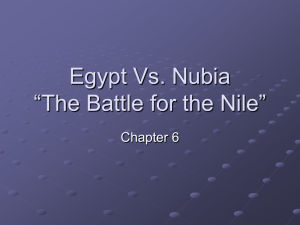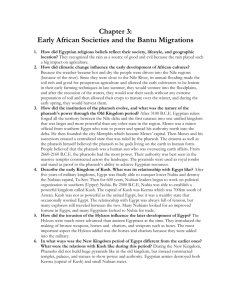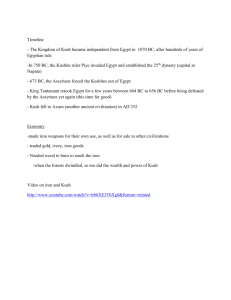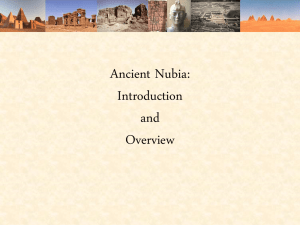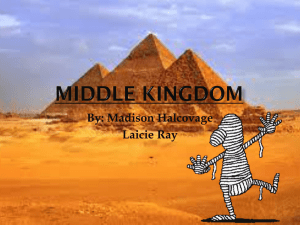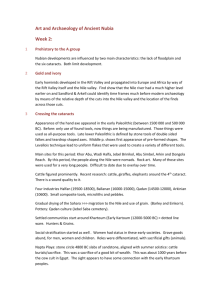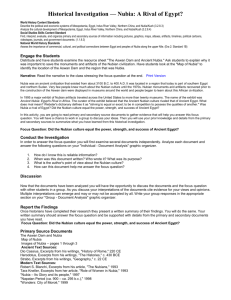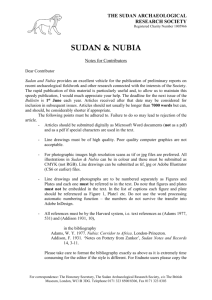1 For recent research on the Mesolithic and Neolithic of Sudan,
advertisement
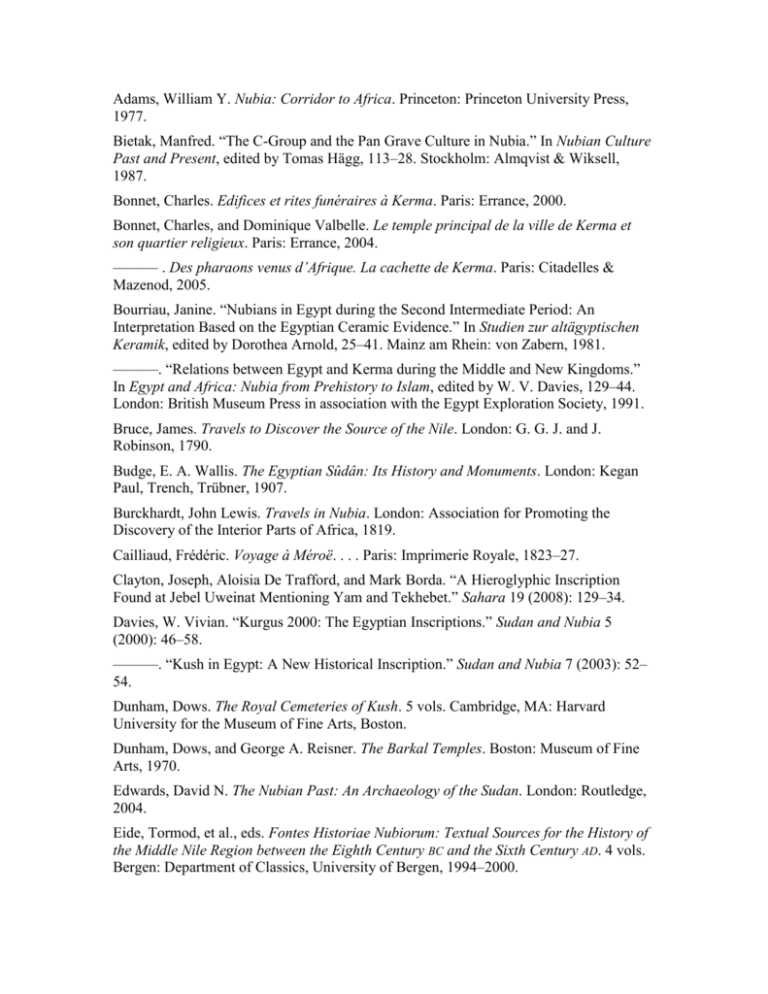
Adams, William Y. Nubia: Corridor to Africa. Princeton: Princeton University Press, 1977. Bietak, Manfred. “The C-Group and the Pan Grave Culture in Nubia.” In Nubian Culture Past and Present, edited by Tomas Hägg, 113–28. Stockholm: Almqvist & Wiksell, 1987. Bonnet, Charles. Edifices et rites funéraires à Kerma. Paris: Errance, 2000. Bonnet, Charles, and Dominique Valbelle. Le temple principal de la ville de Kerma et son quartier religieux. Paris: Errance, 2004. ——— . Des pharaons venus d’Afrique. La cachette de Kerma. Paris: Citadelles & Mazenod, 2005. Bourriau, Janine. “Nubians in Egypt during the Second Intermediate Period: An Interpretation Based on the Egyptian Ceramic Evidence.” In Studien zur altägyptischen Keramik, edited by Dorothea Arnold, 25–41. Mainz am Rhein: von Zabern, 1981. ———. “Relations between Egypt and Kerma during the Middle and New Kingdoms.” In Egypt and Africa: Nubia from Prehistory to Islam, edited by W. V. Davies, 129–44. London: British Museum Press in association with the Egypt Exploration Society, 1991. Bruce, James. Travels to Discover the Source of the Nile. London: G. G. J. and J. Robinson, 1790. Budge, E. A. Wallis. The Egyptian Sûdân: Its History and Monuments. London: Kegan Paul, Trench, Trübner, 1907. Burckhardt, John Lewis. Travels in Nubia. London: Association for Promoting the Discovery of the Interior Parts of Africa, 1819. Cailliaud, Frédéric. Voyage à Méroë. . . . Paris: Imprimerie Royale, 1823–27. Clayton, Joseph, Aloisia De Trafford, and Mark Borda. “A Hieroglyphic Inscription Found at Jebel Uweinat Mentioning Yam and Tekhebet.” Sahara 19 (2008): 129–34. Davies, W. Vivian. “Kurgus 2000: The Egyptian Inscriptions.” Sudan and Nubia 5 (2000): 46–58. ———. “Kush in Egypt: A New Historical Inscription.” Sudan and Nubia 7 (2003): 52– 54. Dunham, Dows. The Royal Cemeteries of Kush. 5 vols. Cambridge, MA: Harvard University for the Museum of Fine Arts, Boston. Dunham, Dows, and George A. Reisner. The Barkal Temples. Boston: Museum of Fine Arts, 1970. Edwards, David N. The Nubian Past: An Archaeology of the Sudan. London: Routledge, 2004. Eide, Tormod, et al., eds. Fontes Historiae Nubiorum: Textual Sources for the History of the Middle Nile Region between the Eighth Century BC and the Sixth Century AD. 4 vols. Bergen: Department of Classics, University of Bergen, 1994–2000. Evans-Pritchard, E. E. The Nuer: A Description of the Modes of Livelihood and Political Institutions of a Nilotic People. Oxford: Oxford University at the Clarendon Press, 1940. ———. Witchcraft, Oracles, and Magic among the Azande. Oxford: Clarendon, 1937. Fernea, Elizabeth W., and Robert A. Fernea. Nubian Ethnographies. Prospect Heights, IL: Waveland, 1991. Fernea, Robert A., and A. Rouchdy. “Contemporary Egyptian Nubians.” In Nubian Culture Past and Present, edited by Tomas Hägg, 365–87. Stockholm: Almqvist & Wiksell, 1987. Fischer, Henry G. “The Nubian Mercenaries of Gebelein during the First Intermediate Period.” Kush 9 (1961): 44–80. Friedman, Renée, et al. “Nubians at Hierakonpolis: Excavations in the Nubian Cemeteries.” Sudan and Nubia 5 (2001): 29–37. de Garis Davies, Nina, and Alan H. Gardiner. The Tomb of Huy, Viceroy of Nubia in the Reign of Tutankhamun. Theban Tombs Series 4. London: Egypt Exploration Society, 1926. Gratien, Brigitte. Les cultures Kerma. Essai de classification. Villeneuve-d’Ascq, France: Université de Lille III, 1978. Haaland, Randi. “Archaeological Classification and Ethnic Groups: A Case Study from Sudanese Nubia.” Norwegian Archaeological Review 10, nos. 1–2 (1977): 1–31. Hafsaas, Henriette. “Pots and People in an Anthropological Perspective: The C-Group People of Lower Nubia as a Case Study.” Cahier de Recherches de l’Institut de Papyrologie et d’Égyptologie de Lille 26 (2006–7): 163–71. Honegger, Matthieu. “The Pre-Kerma: A Cultural Group from Upper Nubia Prior to the Kerma Civilisation.” Sudan and Nubia 8 (2004): 38–46. Kendall, Timothy. “Jebel Barkal: History and Archaeology of Ancient Napata.” www.jebelbarkal.org. ———. Kerma and the Kingdom of Kush, 2500–1500 BC: The Archaeological Discovery of an Ancient Nubian Empire. Exh. cat. Washington, DC: National Museum of African Art, 1997. ———. “Kings of the Sacred Mountain: Napata and the Kushite Twenty-fifth Dynasty of Egypt.” In Sudan: Ancient Kingdoms of the Nile, edited by Dietrich Wildung, 161–71. Paris: Flammarion, 1997 ———. Kush: Lost Kingdom of the Nile. Exh. cat. Brockton, MA: Brockton Art Museum, 1982. ———. “The Origin of the Napatan State: El Kurru and the Evidence for Royal Ancestors.” Meroitica 15 (1999): 3–117. Larson, John A. Lost Nubia. Exh. cat. Oriental Institute Museum Publications 24. Chicago: Oriental Institute, 2006. Also online at http://oi.uchicago.edu/research/pubs/catalog/oimp/oimp24.html. Lepsius, Carl Richard. Denkmäler aus Ägypten und Äthiopien. 12 vols. Berlin: Nicolaische Buchhandlung. Also online at http://edoc3.bibliothek.unihalle.de/lepsius/info.html. Lohwasser, Angelika. Die königlichen Frauen im antiken Reich von Kusch: 25. Dynastie bis zur Zeit des Nastasen. Meroitica 19. Wiesbaden: Harrassowitz, 2001. ———. “Queenship in Kush: Status, Role and Ideology of Royal Women.” Journal of the American Research Center in Egypt 38 (2001): 61–76. Moorehead, Alan. The Blue Nile. New York: Harper & Row, 1962. ———. The White Nile. New York: Harper, 1960. Morkot, Robert G. The Black Pharaohs: Egypt’s Nubian Rulers. London: Rubicon, 2000. O’Connor, David. Ancient Nubia: Egypt’s Rival in Africa. Philadelphia: University Museum of Archaeology and Anthropology, University of Pennsylvania, 1993. ———. “The Locations of Yam and Kush and Their Historical Implications.” Journal of the American Research Center in Egypt 23 (1986): 27–50. O’Connor, David, and A. Reid, eds. Ancient Egypt in Africa. London: UCL Press, 2003. Porter, Bertha, and Rosalind L. B. Moss. Topographical Bibliography of Ancient Egyptian Hieroglyphic Texts, Reliefs, and Paintings. Vol. 7, Nubia, the Deserts, and Outside Egypt. Oxford: Griffith Institute, 1952. Reisner, George A. The Archaeological Survey of Nubia. Vol. 1, Report for 1907–08. Cairo, 1910. ———. Excavations at Kerma. Harvard African Studies 5–6. Cambridge, MA: Peabody Museum, 1923. Rilly, Claude. “L’écriture et la langue de Méroé.” In Méroé, un empire sur le Nil, edited by M. Baud, 144–59. Exh. cat. Paris: Musée du Louvre Éditions, 2001. Roberts, David. Egypt and Nubia. London: F. G. Moon, 1846–49. Säve-Söderbergh, Torgny, ed. Temples and Tombs of Ancient Nubia: The International Rescue Campaign at Abu Simbel, Philae and Other Sites. London: Thames and Hudson; Paris: UNESCO, 1987. Seligman, C. G. Pagan Tribes of the Nilotic Sudan. London: G. Routledge & Sons, 1932. Simpson, William Kelly. Heka-Nefer and the Dynastic Material from Toshka and Arminna. Publications of the Pennsylvania-Yale Expedition to Egypt 1. New Haven: Peabody Museum of Natural History of Yale University, 1963. ———, ed. The Literature of Ancient Egypt. 3rd ed. New Haven: Yale University Press, 2003. Smith, Stuart Tyson. Wretched Kush: Ethnic Identities and Boundaries in Egypt’s Nubian Empire. London: Routledge, 2003. Török, László. The Kingdom of Kush: Handbook of the Napatan-Meroitic Civilization. Leiden: E. J. Brill, 1997. ———. “The Origin of the Napatan State: The Long Chronology of the El Kurru Cemetery.” Meroitica 15 (1999): 149–59. Tsakos-Hafsaas, Henriette. “The Kingdom of Kush: An African Centre on the Periphery of the Bronze Age World System.” Norwegian Archaeological Review 42, no. 1 (2009): 50–70. Vercoutter, Jean. “The Gold of Kush.” Kush 7 (1959): 120–53. Welsby, Derek A. The Kingdom of Kush: The Napatan and Meroitic Empires. London: British Museum Press, 1996. Welsby, Derek A., and Julie R. Anderson, eds. Sudan: Ancient Treasures. Exh. cat. London: British Museum Press, 2004. Wildung, Dietrich. “The Treasure of Amanishakheto.” In Sudan: Ancient Kingdoms of the Nile, edited by Wildung, 302–40. Paris: Flammarion, 1997. Williams, Bruce B. The A-Group Royal Cemetery at Qustul: Cemetery L. Oriental Institute Nubian Expedition 3. Chicago: Oriental Institute of the University of Chicago, 1986. Williams, Bruce, and Thomas J. Logan. “The Metropolitan Museum Knife Handle and Aspects of Pharaonic Imagery Before Narmer.” Journal of Near Eastern Studies 46, no. 4 (1987): 245–85. Regular updates on research on Nubia are published in these series: ArchéoNil Cahier de Recherches de l'Institut de Papyrologie et d'Égyptologie de Lille Der Antike Sudan. Mitteilungen der Sudanarchäologischen Gesellschaft zu Berlin Gdansk Archaeological Museum African Reports Kush Meroitica Polish Archaeology in the Mediterranean Sudan and Nubia
